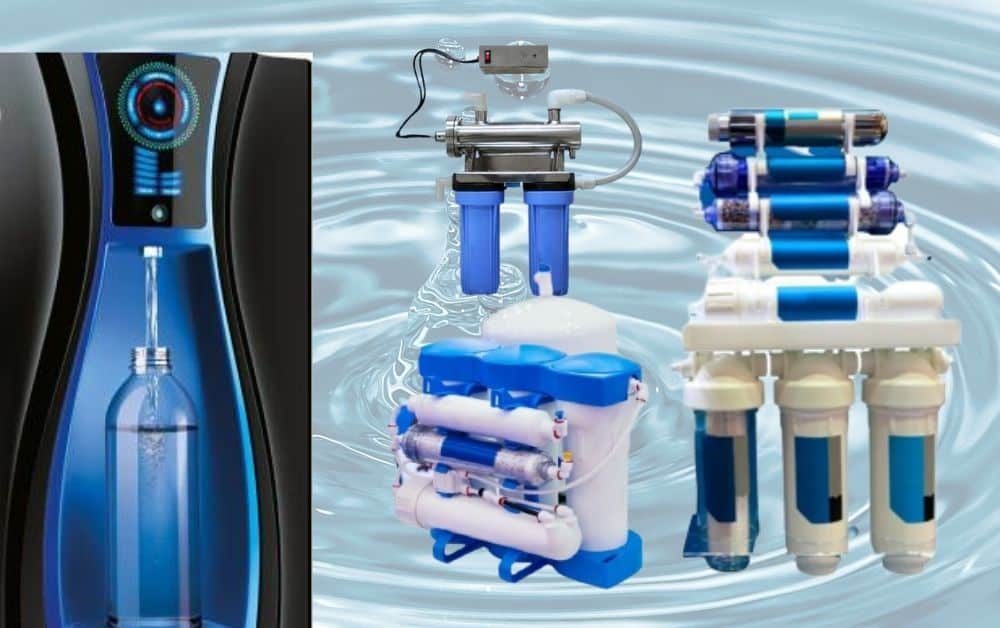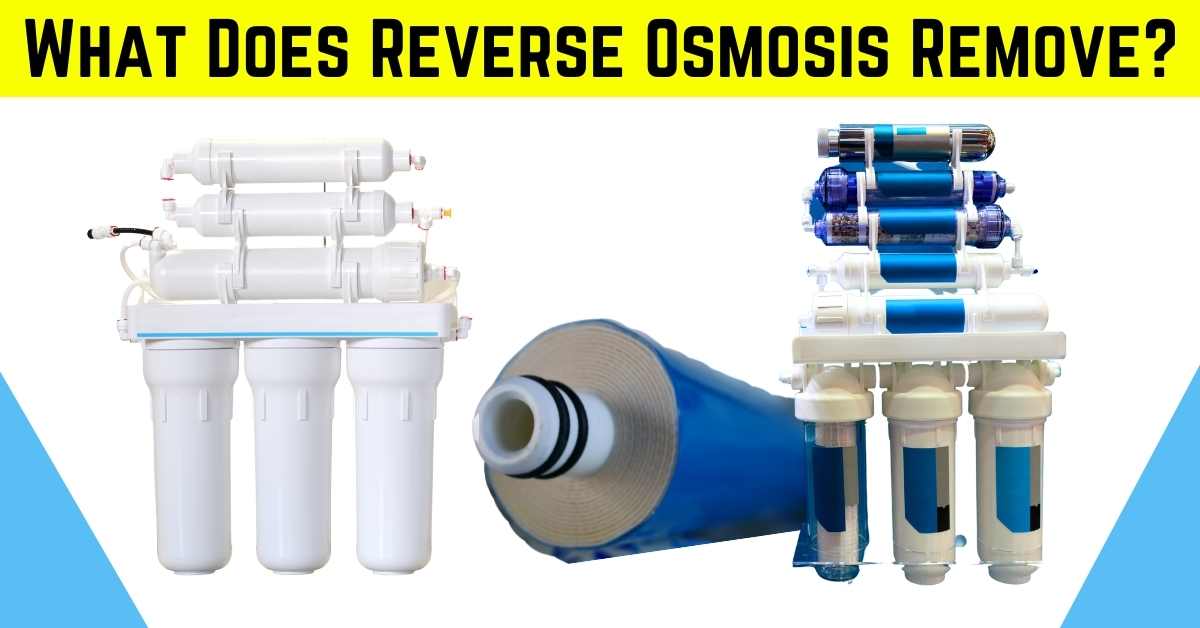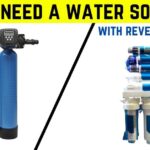Our drinking water is full of minerals that can risk our health. Therefore, before choosing a RO to filter, it is essential to know “What does reverse osmosis remove?”
These molecules are more physically large than water molecules, so removing them using RO filtration is easy.
The premium reverse osmosis device can remove up to 99.99 percent of harmful substances from the water supply.
The issue is whether eliminating the minerals essential to our body’s proper function is healthy. Let’s find out.
How Does Reverse Osmosis Work?
In Reverse Osmosis, applied pressure is utilized to beat the pressure of Osmosis and feed water from high levels of contaminants to a lower concentration of contaminants.
It’s because it’s forced into reverse, and the contaminated water is trying to flow into pure water.
However, because it needs to go through an initial water filter so that the contaminants remain and only pure water flows through, this results in clean drinking water, as we need!
Reverse Osmosis generally comprises four phases of filtration to remove contaminants, including the sediment filter, pre-carbon block, reverse osmosis membrane, and post-carbon filters.
The sediment filter removes the most massive particles, such as dirt, sand, and corrosion, to keep them from other filters.
The pre-carbon water filter uses activated carbon to stop anything bigger than a small amount of flour from entering the filter.
And also binding and attracts positively charged ions to block chemical compounds, such as chloramines and chlorine, from getting through to the next filter.
Reverse osmosis membrane eliminates heavier molecules than water, like sodium, and the high concentrations of lead, dissolved minerals, and fluoride.
The post-carbon filters polish the water and make the perfect RO system for the Apartment.
What Does Reverse Osmosis Remove From Drinking Water?
The reverse osmosis procedure makes use of a semipermeable membrane for the removal of various contaminants.
Here is a brief list of the impurities eliminated from the water by RO.

| Ions and metals | Organic chemicals | Pesticides | Particles |
| 85 – 95% Potassium | Carbon tetrachloride* | Lindane | Asbestos |
| 94 – 98% Magnesium | Benzene* | Endrin | Protozoan cysts |
| 94 – 98% Calcium | Dichlorobenzene* | Pentachlorophenol | Cryptosporidium |
| 94 – 98% Iron | Toluene* | 1,2,4-trichlorobenzene* | |
| 94 – 96% Selenium | Trihalomethanes* | 2,4-D* | |
| 92 – 96% Arsenic | Trichloroethylene* | Atrazine* | |
| 95 – 98% Mercury | Heptachlor | ||
| 85 – 94% Sodium | |||
| 95 – 98% Zinc | |||
| 95 – 98% Lead | |||
| 85 – 92% Chloride | |||
| 94 – 98% Manganese | |||
| 96 – 98% Nickel | |||
| 95 – 98% Cadmium | |||
| 95 – 98% Barium | |||
| 60 – 75% Nitrate | |||
| 96 – 98% Sulfate | |||
| 96 – 98% Phosphate | |||
| 84 – 92% Cyanide | |||
| 85 – 92% Fluoride | |||
| Aluminum | |||
| Silver | |||
| Chromium | |||
| Radium | |||
| Fluoride | |||
| Copper | |||
| Chlorine* | |||
| Radon* |
*The only way to get rid of these contaminants is to ensure your reverse osmosis water device has an integrated carbon filter.
You can quickly know what reverse osmosis systems remove from your house water from the above list.
For instance, when fluoride is your primary concern, it is evident that a RO system can remove up to 92% from your water.
What Does Not Reverse Osmosis Remove?
Certain pollutants are smaller in molecular size than water. Reverse Osmosis isn’t always the panacea that many believe it is in terms of giving clean water of contaminants.
Some of the most common contaminants that can pass through the typical RO filter include:
- Pesticides
- Herbicides
- Other agricultural products, such as fungicides
- Some dissolved gasses, like hydrogen sulfide
- Certain organic compounds
- Chlorine RO can remove different amounts of chlorine. However, the typical home RO filter might not remove all chlorine in the water, although it will depend on the chemical concentration within the water supply.
Best Reverse Osmosis Filter Alternatives
Boiling Water
One of the most secure and efficient methods to get pure distilled water is boiling it.
Since the beginning, boiling has been among the most widely used and traditional methods utilized in all households. It was first introduced long before reverse osmosis purifiers were created.
Put the water into the pot and set it on a gas or electric stove.
You need to heat water at high temperatures until it is boiling. If it appears to be cloudy, it could be contaminated with dirt. Therefore, you should clean the water using a paper towel or cloth before you boil it.
Please ensure the water is at a rolling boil to ensure it is boiling accurately. Allow the steam to then churn for a few minutes.
Let the distilled water cool before drinking.
City Water Softener
If you are experiencing hard water flowing through your pipes and looking for an easy solution, check out water softeners for your home.
These devices will remove the minerals that cause hardness, magnesium, and calcium from your water, making it safe for home use.
It’s true that the cost of water softeners is low, enough that the average family could quickly put it within their homes to get bottled water quality.
If you’re searching for a water softener that will fit your home, ensure that the model you select can be installed quickly and has solid construction.
Purifying Through Chlorination
Purifying chemicals are used to purify water by adding chlorine tablets.
The chlorination of water helps kill numerous harmful bacteria and pollutants. Put four drops of bleach in a liter of 8 each half gallon.
Allow it to rest for at least half an hour to make the water drinkable.
The minimum temperature of untreated water must not be lower than 16 degrees Celsius to effectively water chlorination.
The water may appear different; however, the great news is that it’s safe to drink.
Although chlorine is cheap and readily available, you should keep your eyes on the fact that too much chlorine may harm your health and remain cautious.
Additionally, with chlorine, you can’t guarantee completely removing all complex microorganisms found in water.
The Myths and Truths of RO Water
Myth 1. RO purified water is unhealthy to drink
Some detractors claim that purified water is artificial and unhealthful and should be used only in industrial settings and not for human consumption.
They claim that RO water isn’t pure and clean for it to count as healthy because this kind of mineral-free, pure water isn’t found on the planet. However, this type of water exists and is known as RAIN.
The fact is that Reverse Osmosis removes impurities from the water that is clean and safe to drink. Research has proven RO drinking water to be pure with no adverse side effects over more than 60 years of studies.
The US military has extensively tested RO technology. It has been widely used as drinking water for soldiers and civilians serving in our military.
MYTH 2. RO takes healthy minerals out of water
RO systems can take out minerals from the tap water. However, humans acquire most of our minerals from the food we consume, in contrast to drinking water.
For instance, a glass of juice from an orange contains precisely the amount of mineral content as 30 gallons of tap water.
Additionally, you will receive more minerals from one vitamin tablet than by drinking a month’s filtered water supply.
According to WQA, in conjunction with the WHO, we get the bulk of the minerals we need from our food, not drinking water. Inorganic minerals in water have little or no effect and can harm our health.
Myth 3 RO removes minerals in the body.
Reverse Osmosis water cannot remove minerals from human bodies. Water is the universal solvent since it constantly “wants” to have substances dissolve within it.
The more pure the water is, the more aggressive it is in attacking objects that can dissolve.
It doesn’t harm the human body since our physiology quickly achieves homeostasis through saliva, stomach fluids, and other fluids to balance all bodily fluids.
No scientifically proven evidence that reverses osmosis-treated water could eliminate minerals from the human body.
Myth 4. RO wastes a lot of water
RO utilizes specific amounts of water to ensure durability and quality. For every gallon of pure water created by an RO system, the average is 4 Gallons of brine water being used up and disposed of.
The brine (waste) liquid cleanses the RO membrane, letting the filter work efficiently and last for years.
In reality, many people use discarded water to water plants and gardens or store it for other household tasks.
Do I Require RO Filter to Have Pure Water At Home?
Over the last 10-15 years, an alkaline water filtration system has been advertised as the best solution for drinking water at home when combined with activated carbon.
Before buying the best whole house RO system unit or additional purification equipment, check the tap water quality at home and the requirements to ensure it is delicious and safe.
Advantages (pros) of Reverse Osmosis
- Proven technology ensures pure drinking water.
- A better option for hard water treatment.
- Produce high-quality tap water free from heavy metals, bacteria and dissolved solids.
- Ro water treatment systems can improve water quality and give clean water like bottled water.
- Tap water can be made drinkable by making rich minerals (TDS 1500 or more ) drinkable.
- RO water purifier protects the user from waterborne infections that can be harmful.
- It can improve metabolism & digestion.
- RO water treatment system can help improve the appearance of skin, hair and losing weight.
The disadvantages (cons) of the Reverse Osmosis
- The amount of waste produced is as high as six times that of pure water.
- Requires professional support to ensure its effectiveness and security.
- It eliminates healthy minerals like potassium, magnesium, calcium, and bicarbonates, so you must remineralize RO water.
- The cost is relatively high, starting at $300 plus maintenance and repairs.
Conclusion: (What Does Reverse Osmosis Remove?)
Reverse Osmosis System can remove various harmful contaminants and provide fresh water across the globe in which water is scarce and for industrial wastewater cleaning.
It could also be an effective solution to filter contaminants, dissolved solids, heavy metals, and household use in situations requiring it.
But, in the majority of instances, they consume municipal water. An activated carbon faucet filter can provide delicious fresh tap water for less cost and lower waste.
FAQ
Does reverse Osmosis eliminate fluoride?
Reverse Osmosis can remove harmful substances and fluoride from the tap or well-brown water.
It happens steadily, characterized by water entering the chamber and passing into the RO membrane. Then the wastewater flows out through the drainpipe.
Because fluoride particles aren’t significant to pass across the semipermeable membrane, they’re eliminated from the system, along with most other contaminants in the tap water.
Can reverse Osmosis remove bacteria and viruses?
RO membrane filter has pores of around 0.0001 microns. For illustration, bacteria like E. coli and salmonella are between 0.2 – 4 microns in diameter. They are too big to pass into the pores.
According to a study published by the CDC, Reverse Osmosis systems have very high efficiency in the:
1. Get rid of protozoa (e.g., Giardia, Cryptosporidium)
2. Eliminating the bacteria (e.g., Salmonella, Shigella, Campylobacter, E. coli)
3. Remove viruses (e.g., Hepatitis A, Norovirus, Enteric, Rotavirus).
To return to the issue: Yes, it does, and it works effectively for various contaminants and viruses transferred through water.
Does reverse Osmosis remove chlorine?
Yes! The reverse osmosis filtration system removes chlorine by passing it through several stages of filtering and making alkaline water at your home quickly.
If you’ve conducted any investigation on removing chlorine, activated Carbon filters are indeed extremely efficient in removing chlorine.
Does reverse Osmosis take salt out of the seawater?
Reverse Osmosis is a highly effective method of removing salt and other impurities from seawater.
Through a semipermeable membrane, the process separates water molecules from salt ions, producing clean and drinkable water.
Reverse Osmosis is widely used in desalination plants and can provide a sustainable solution to water scarcity in coastal regions.






